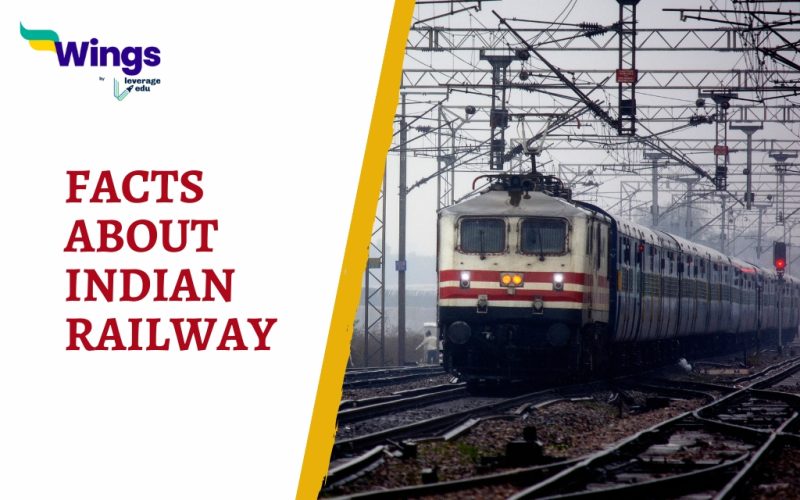Since the days of steam and coal engines, Indian Railways has undergone significant development and progress over the course of its history. A bullet train is going to be operated by the Railways of India in the near future. In terms of the transportation system in our country, the development of railways in India is considered the most important component. Did you know it has its own ministry and budget? Moreover, it assists a significant portion of the country’s population in order to help them successfully run their day-to-day businesses. Here are some other interesting facts about Indian Railways for your exams.
Historical Facts about Indian Railways
Table of Contents [show]
- In 1832, British India first proposed the idea of setting up a new railway station in colonized India.
- Many proposals for Indian railways were made in the 1840s, mainly around Calcutta and Bombay.
- 1845 was the year that a railway operation around Rajahmundry was built, named the Godavari Dam Construction Railway.
- The East India Railway followed the construction of the Madras Railway in 1845.
- On August 1, 1849, the Great Indian Peninsular was created by an Act of Parliament.
- In 1842, the Madras Guaranteed Railway Company came into existence.
Amazing Fun Facts about Indian Railways
- Indian Railways is considered to have a 169-year-old heritage.
- The first passenger train in India ran between Mumbai’s Bori Bandar and Thane, which covered an area of about 34 kilometres.
- Bholu, which is an elephant dressed as a railway guard, is considered the mascot of the Indian Railways.
- It was in 2002 that the mascot came into existence when the National Institute of Design crafted it on the 150th anniversary of railways.
- India’s railway system is the fourth largest railway network, followed by the US, Russia, and China.
- The Darjeeling Himalayan Railway, Chhatrapati Shivaji Terminus, Nilgiri Mountain Railway, and Kalka Shimla Railway are the four UNESCO world heritage sites owned by Indian Railways.
- The Indian Railways is considered to have 34 operational and 3 under-construction rail museums, heritage galleries, and art galleries that showcase its vast history as the nation’s transportation lifeline.
- With an area of about 1,366 meters in length, India’s railway system is considered to have the world’s longest platform, situated at Gorakhpur station.
- Royal Rajasthan on Wheels, Palace on Wheels, The Golden Chariot, The Maharajas Express, and the Deccan Odyssey are the five royal trains owned by the Indian Railways.
- Mathura Junction, also known as the MTJ, is considered one of India’s most important railway stations because the maximum number of routes emerge from it.
- The railway spends approximately 94% of its earnings on running trains and their smooth operation.
- The Diamond Crossing in Nagpur is from where the trains go to the east, west, north, and south.
- The Indian Railway is building the world’s tallest rail arch bridge using steel and concrete to cross the Chenab River.
- With employing approximately 1.4 million in India, the railway is considered the largest employer in the country.
- With 23 platforms that handle over 1 million passengers daily, Howrah Junction is considered the busiest railway station.
- Electric lights, fans, and outlets in train cars in India run on 110 volts, whereas in the home they only use 220 volts.
- There are a total of ten different classes of travel on the Indian Railways, which are categorized as 1AC, 2AC, 3AC, 3AE, EC, CC, FC, SL, 2S, and IIUR.
- The Shatabdi Express is India’s fastest-running train, travelling at a top speed of about 150 kilometres per hour.
- Indian Railways launched the Red Ribbon Express, a public awareness campaign train, on December 1, 2007, World AIDS Day.
- According to the Guinness Book of World Records, the New Delhi Railway Station interlocking system is considered the world’s largest route delay system.
- The Oldest Working Indian Locomotive, known as Fairy Queen, still functions as a passenger train between Delhi and Alwar.
- Pir Panjal, which is located in the middle Himalayas in Jammu and Kashmir, is the longest rail tunnel in India.
- Ahmednagar, Srirampur, and Belapur railway stations are located on opposite tracks of the same station.
Hope you had fun reading these interesting facts about Indian Railways. If you like reading about facts, you can visit our interesting facts page to read more such blogs.
 One app for all your study abroad needs
One app for all your study abroad needs















 45,000+ students trusted us with their dreams. Take the first step today!
45,000+ students trusted us with their dreams. Take the first step today!
